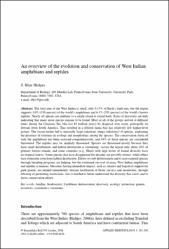| Author | Hedges, S. Blair | |
| Accessioned date | 2022-10-25T17:24:32Z | |
| Available date | 2022-10-25T17:24:32Z | |
| Year | 2006 | |
| Citation | Hedges, S. Blair (2006). An overview of the evolution and conservation of West Indian amphibians and reptiles. Applied Herpetology, 3, 281-292. Recuperado de: | es |
| URI | https://bvearmb.do/handle/123456789/1689 | |
| Abstract | The total area of the West Indies is small, only 0.15% of Earth’s land area, but the region supports 3.0% (180 species) of the world’s amphibians and 6.3% (520 species) of the world’s known reptiles. Nearly all species are endemic to a single island or island bank. Rates of discovery are high indicating that many more species remain to be found. Most or all of the groups arrived at different times during the Cenozoic Era (the last 65 million years) by dispersal over water, principally on flotsam from South America. This resulted in a filtered fauna that has relatively few higher-level groups. The vacant niches led to unusually large radiations (mega-radiations) of species, explaining the presence of extremes in ecology and morphology among the species. The conservation status of only the amphibians has been assessed comprehensively, and 84% of those species are considered threatened. The reptiles may be similarly threatened. Species are threatened mostly because they have small distributions and habitat destruction is continuing. Across the region only about 10% of primary forests remain, and some countries (e.g., Haiti) with high levels of faunal diversity have no original forests. Some species that have disappeared for decades are possibly extinct, while others face extinction soon from habitat destruction. Efforts to curb deforestation and to save targeted species through breeding programs are helping, but the continued survival of many West Indian amphibians and reptiles is tenuous. Measures having immediate impact, such as salaries and logistical support for park guards, are needed immediately. Greater facilitation of biotic surveys and inventories, through relaxing of permitting restrictions, also is needed to better understand the diversity that exists and to focus conservation efforts. | es |
| Language | English | es |
| Published | Applied Herpetology, 3, 281-292 | es |
| Rights | © Koninklijke Brill NV, Leiden, 2006. | es |
| Subject | Biodiversidad | es |
| Subject | Deforestación | es |
| Subject | Ecología | es |
| Subject | Hábitats y especies | es |
| Subject | Especies extintas | es |
| Subject | Biología | es |
| Subject | Historia natural | es |
| Title | An overview of the evolution and conservation of West Indian amphibians and reptiles | es |
| Material type | Article | es |
| Type of content | Scientific research | es |
| Access | Open | es |
| Audience | Technicians, professionals and scientists | es |


